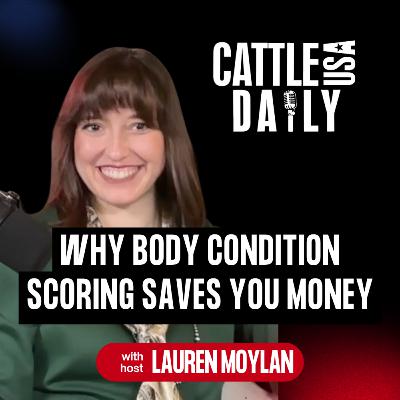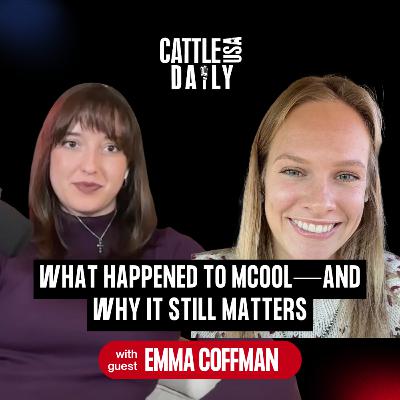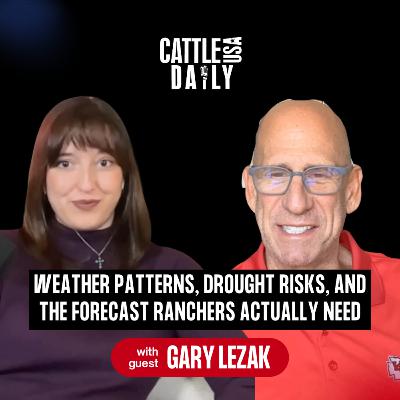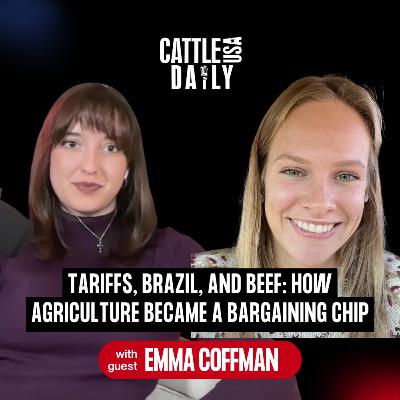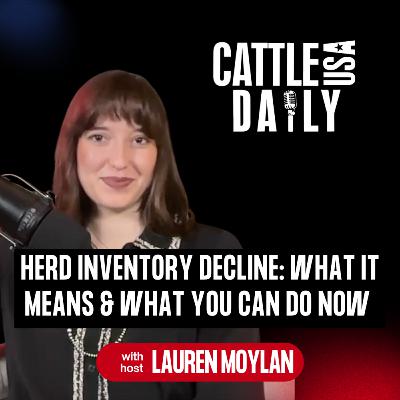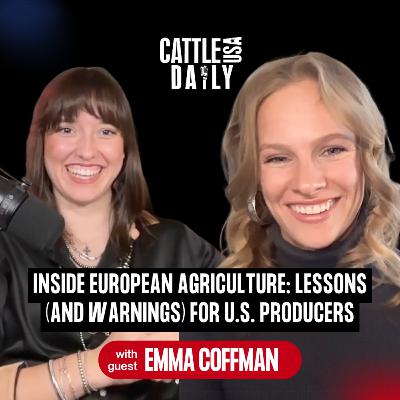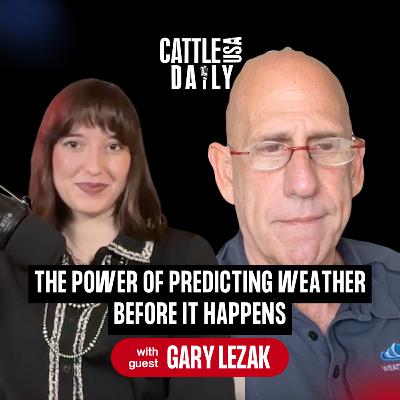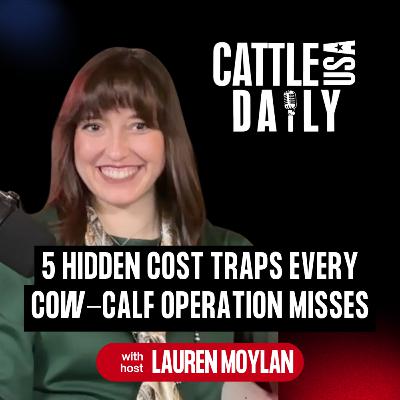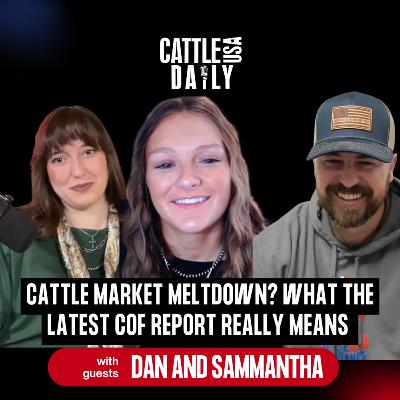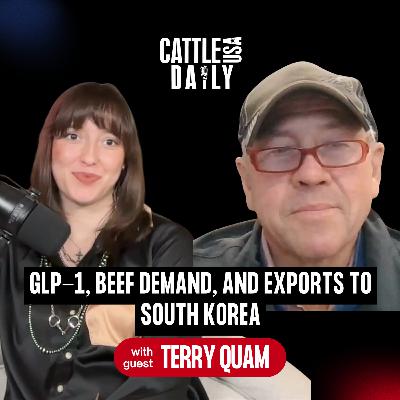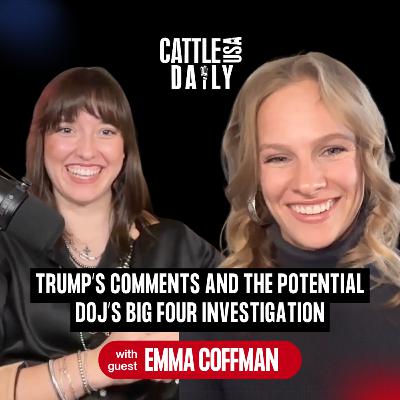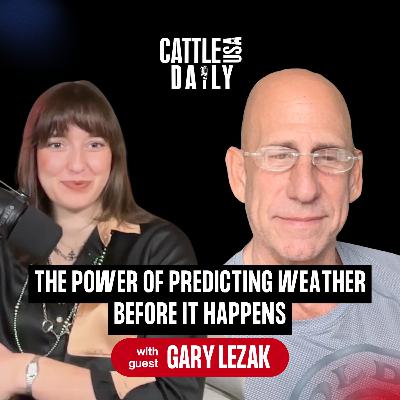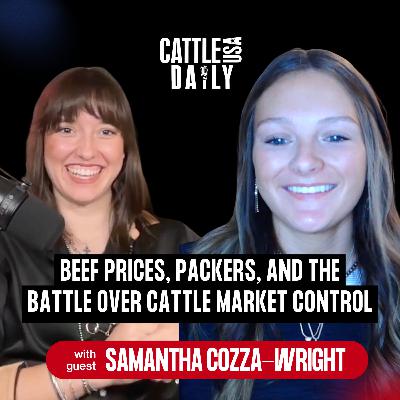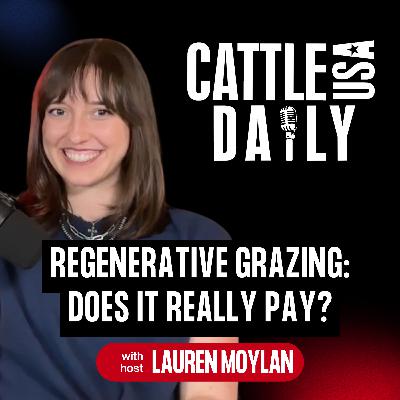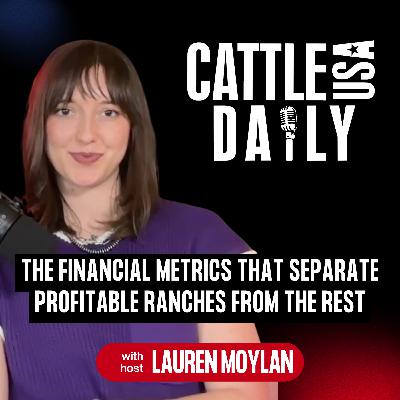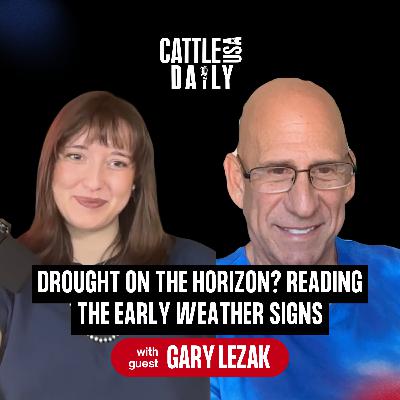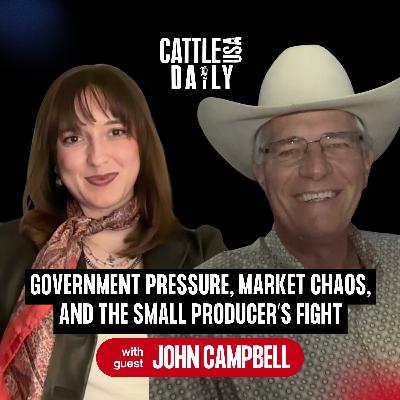Discover CattleUSA Daily
CattleUSA Daily

CattleUSA Daily
Author: Lauren Moylan | Cattle USA
Subscribed: 10Played: 152Subscribe
Share
© Lauren Moylan | Cattle USA
Description
CattleUSA Daily delivers fast, factual insight into cattle markets, sale barn results, and beef industry trends across the U.S. Hosted by producers and professionals who live the business, each episode breaks down feeder and fat cattle prices, futures movement, packer demand, weather impacts, and export shifts shaping today’s beef economy. From ranch-level realities to national market drivers, CattleUSA Daily is the trusted source for livestock news, market analysis, and ag insight that helps producers make confident, informed decisions every day.
211 Episodes
Reverse
Body condition scoring isn’t a side task. It’s one of the most accurate predictors of profitability in a cow-calf operation. In this episode, we dig into why BCS matters, how it ties directly to reproduction, feed savings, and weaning weights, and the checkpoints every producer should be scoring at. When you understand the fat cover on your cows, you can manage nutrition before it becomes a crisis, spot forage problems early, and put real dollars back into your operation.LinksCattleUSA Insurance - https://info.cattleusainsurance.com/l/1102253/2025-06-04/288f5mCattleUSA Website - https://www.cattleusa.com/Facebook - https://www.facebook.com/cattleusamediaInstagram - https://www.instagram.com/cattleusa.media/Subscribe to our newsletter - https://www.cattleusadrive.com/CattleUSA Media - https://www.cattleusamedia.com/Lauren’s Instagram - https://www.instagram.com/_laurenmoylan/Lauren’s Youtube - https://www.youtube.com/@ShowboatmediacoThe Next Generation Podcast Website - https://www.thenextgenag.com/TakeawaysBody condition scoring is a powerful management tool.BCS measures fat reserves on a scale from 1 to 9.Cows with a BCS of 5 or better breed back faster.Research links BCS to profitability in cattle operations.Maintaining condition can save thousands in feed costs.Scoring should occur at multiple key checkpoints.Thinner cows require higher quality feed.BCS trends can indicate forage quality issues.Knowing BCS helps in negotiating prices for heifers.Regular scoring is essential for herd health management.Chapters00:00 Understanding Body Condition Scoring (BCS)02:43 The Financial Impact of BCS on Ranching03:57 Implementing BCS for Better Herd ManagementBody Condition Scoring, BCS, cattle management, herd health, profitability, nutrition, reproduction, feed savings, cow scoring
The conversation takes a deep dive into the debate surrounding M-COOL (Mandatory Country of Origin Labeling) as host Lauren Moylan and guest Emma Coffman unpack how the policy was created, why it was dismantled, and what its absence means for both producers and consumers. They cut through the noise around labeling laws, imported beef, and trade pressures that shape the U.S. food system, offering clarity on what’s true, what’s misunderstood, and what the industry needs moving forward. The discussion closes with a lighter look at holiday food traditions and why beef often wins out over turkey at the Thanksgiving table.LINKSEmma's Links - https://linktr.ee/doubleeranch CattleUSA Website - https://www.cattleusa.com/ Facebook - https://www.facebook.com/cattleusamedia Instagram - https://www.instagram.com/cattleusa.media/ Subscribe to our newsletter - https://www.cattleusadrive.com/ CattleUSA Media - https://www.cattleusamedia.com/ Lauren’s Instagram - https://www.instagram.com/_laurenmoylan/ Lauren’s Youtube - https://www.youtube.com/@Showboatmediaco The Next Generation Podcast Website - https://www.thenextgenag.com/TAKEAWAYSM-COOL refers to Mandatory Country of Origin Labeling, a policy removed due to international trade pressures.Consumer demand for transparency is rising, but current trade rules limit how beef can be labeled.Imported beef must meet strict U.S. safety standards despite lacking origin labeling.Local producers often provide premium products at prices that reflect real production costs.The beef supply chain includes regulators, packers, trade partners, and independent ranchers.Fear-based messaging around imported beef creates unnecessary confusion.Efforts to reinstate M-COOL must consider potential trade retaliation.Transparency and education are essential for rebuilding consumer trust.Holiday seasons amplify conversations about food origins and quality.CHAPTERS00:00 Thanksgiving Banter and Setting the Conversation03:25 What M-COOL Really Means06:05 How Origin Labeling Shapes Consumer Understanding09:07 Trade Barriers and the Challenges of Reinstating M-COOL11:54 Safety, Transparency, and the Future of Beef Labeling16:09 Closing Thoughts and Holiday Food TraditionsM-COOL, beef industry, country of origin labeling, USDA, consumer education, transparency, agriculture, food safety, trade policies, Thanksgiving, beef imports, labeling laws, ranching, cattle industry, agricultural policy
In this episode, Gary and Lauren Moylan break down what’s actually happening in the atmosphere right now and why it matters for agriculture. The pattern is cycling, the drought map is shifting, and the next few weeks will tell us whether we’re headed toward relief or tightening conditions. We also get into the gap between real forecasting and media hype, how long-range models can be right more often than people think, and what producers should be watching as we move into the next phase of this weather cycle.LinksWeather 20/20 Dashboard Discount - https://www.weather2020.com/partner/cattle-usaSubstack - https://weather2020.substack.com/The Global Predictor App - https://www.weather2020.com/global-predictor-mobile-appYoutube -https://www.youtube.com/@Weather2020Follow Gary on X - https://x.com/glezak CattleUSA Insurance - https://info.cattleusainsurance.com/l/1102253/2025-06-04/288f5mCattleUSA Website - https://www.cattleusa.com/Facebook - https://www.facebook.com/cattleusamediaInstagram - https://www.instagram.com/cattleusa.media/Subscribe to our newsletter - https://www.cattleusadrive.com/CattleUSA Media - https://www.cattleusamedia.com/Lauren’s Instagram - https://www.instagram.com/_laurenmoylan/Lauren’s Youtube - https://www.youtube.com/@ShowboatmediacoThe Next Generation Podcast Website - https://www.thenextgenag.com/TakeawaysThe weather pattern is currently cycling and evolving.Understanding weather cycles is crucial for agricultural planning.Drought conditions can expand or contract based on weather patterns.Accurate long-range forecasting can help mitigate risks in agriculture.Media hype can distort public perception of weather events.Forecasting accuracy varies, with some predictions being up to 90% accurate.The current weather cycle may lead to increased fire risks in certain regions.The importance of monitoring drought conditions for farmers and ranchers.Weather patterns can significantly impact planting and harvest schedules.The full weather report will provide insights for the upcoming months.Chapters00:00 Navigating Busy Lives and Travel Challenges11:25 Understanding Weather Patterns and Their Impact20:35 The Importance of Accurate Weather Forecastingweather, drought, agriculture, forecasting, climate, patterns, storms, predictions, media, podcast
The tariffs on Brazilian beef are back in the headlines, and this time Trump’s decision to lift them has the entire industry on edge. In this episode, we break down what a return to 26% actually means, why agriculture keeps getting used as a political bargaining chip, and how these changes ripple all the way from ranchers to consumers buying ground beef at the store. Lauren and Emma dig into quality concerns, transparency issues, and the long-term implications for a supply chain already stretched thin. This conversation clears the noise so producers can understand what’s signal — and what’s politics.LinksEmma's Links - https://linktr.ee/doubleeranch CattleUSA Website - https://www.cattleusa.com/ Facebook - https://www.facebook.com/cattleusamedia Instagram - https://www.instagram.com/cattleusa.media/ Subscribe to our newsletter - https://www.cattleusadrive.com/ CattleUSA Media - https://www.cattleusamedia.com/ Lauren’s Instagram - https://www.instagram.com/_laurenmoylan/ Lauren’s Youtube - https://www.youtube.com/@Showboatmediaco The Next Generation Podcast Website - https://www.thenextgenag.com/TakeawaysTrump lifted tariffs on Brazilian beef, returning to 26%.Agriculture is often used as a bargaining chip in trade.Consumers are most affected by rising ground beef prices.The U.S. is the most efficient beef producer globally.There is a need for transparency in agricultural decisions.Imported beef can be labeled as a product of the USA.The beef industry is facing challenges due to political changes.Producers are concerned about the quality of imported beef.The agricultural sector needs to remain hopeful despite challenges.Future policies should prioritize transparency and communication.Chapters00:00 Introduction and Context of Tariffs03:17 Impact of Tariff Changes on Agriculture05:59 The Role of Agriculture as a Bargaining Chip08:54 Concerns Over Beef Imports and Quality11:53 Transparency and Future Outlook for Agriculturetariffs, agriculture, beef production, trade negotiations, US market, transparency, supply chain, consumer impact, political decisions, livestock
The cattle market is getting hit from every direction right now. Tyson shutting down a major beef plant, tariffs lifted on Brazilian beef, a bearish cattle-on-feed report, and mounting questions around market manipulation have all collided in the same week. In this episode, we break down what actually matters, what’s noise, and what producers should be watching as the fundamentals shift. From heifer retention to grain markets to the long-term impact on domestic prices, this conversation digs into the real pressures facing cattle producers and the decisions that’ll shape 2025 and beyond.LinksCattleUSA Insurance - https://info.cattleusainsurance.com/l/1102253/2025-06-04/288f5mCattleUSA Website - https://www.cattleusa.com/Facebook - https://www.facebook.com/cattleusamediaInstagram - https://www.instagram.com/cattleusa.media/Subscribe to our newsletter - https://www.cattleusadrive.com/CattleUSA Media - https://www.cattleusamedia.com/Lauren’s Instagram - https://www.instagram.com/_laurenmoylan/Lauren’s Youtube - https://www.youtube.com/@ShowboatmediacoThe Next Generation Podcast Website - https://www.thenextgenag.com/TakeawaysCattle values have fallen significantly, impacting producers.Market manipulation and monopolization are concerns in the beef industry.Tyson's plant closure raises questions about future supply and processing capacity.The removal of tariffs on Brazilian beef could affect domestic prices.Heifer retention strategies are shifting as producers respond to market conditions.The grain market outlook remains cautious amid fluctuating prices.Consumer demand for beef remains high despite falling cattle prices.The cattle market is experiencing volatility and uncertainty.Producers are advised to stay informed and adaptable to market changes.Future cattle supplies may increase as herd management strategies evolve.Chapters00:00 Winter Arrivals and Market Updates06:14 Cattle Market Dynamics and Price Manipulation10:45 Government Influence and Market Competition15:26 Impact of Plant Closures on Local Communities19:54 Heifer Retention and Future Supply Concerns24:20 Grain Market Insights and Future Predictionscattle markets, beef prices, Tyson, Brazilian beef, cattle on feed, market manipulation, heifer retention, grain market, livestock industry, agricultural economy
The U.S. cow herd is the smallest it’s been in decades, and it’s reshaping every corner of the cattle market. In this episode, we break down why the CalHERD keeps shrinking, what it means for calf supplies and future prices, and what ranchers must focus on to stay profitable in a tight inventory environment. High prices only help if your cows stay bred, fed, and productive. This is the playbook for managing risk, protecting your assets, and positioning your operation in a cycle that rewards discipline.LinksCattleUSA Insurance - https://info.cattleusainsurance.com/l/1102253/2025-06-04/288f5mCattleUSA Website - https://www.cattleusa.com/Facebook - https://www.facebook.com/cattleusamediaInstagram - https://www.instagram.com/cattleusa.media/Subscribe to our newsletter - https://www.cattleusadrive.com/CattleUSA Media - https://www.cattleusamedia.com/Lauren’s Instagram - https://www.instagram.com/_laurenmoylan/Lauren’s Youtube - https://www.youtube.com/@ShowboatmediacoThe Next Generation Podcast Website - https://www.thenextgenag.com/TakeawaysThe U.S. CalHERD is at its lowest inventory in decades.Multiple factors have contributed to the herd decline, including drought and high feed costs.A smaller herd leads to fewer calves and tighter supplies, supporting higher prices.Ranchers need to manage costs and risks effectively to benefit from high prices.Retaining ownership of cattle is more attractive in a low inventory environment.High prices do not guarantee high profits; careful management is essential.Maintaining cow condition and nutrition is critical for profitability.Ranchers should be proactive in managing reproduction and breeding seasons.Interest rates significantly impact financing and cash flow for ranchers.A shrinking herd presents opportunities for disciplined and efficient operations.Chapters00:00 Understanding the Decline of the U.S. CalHERD02:53 Strategies for Ranchers in a Tight Market05:54 Navigating Opportunities and Risks in Cattle ManagementU.S. CalHERD, cattle prices, ranching strategies, herd inventory, livestock management, beef market, rancher tips, cattle cycle, feed costs, reproduction management
European agriculture looks different—and not always in a good way. In this episode of the CattleUSA Daily Podcast, Lauren Moylan sits down with Emma Coffman to unpack what she learned from her recent trip across Europe’s farms. They discuss the maze of EU regulations, sustainability mandates, and animal welfare policies shaping the region—and how they compare to U.S. agriculture. The conversation dives into what American producers can learn from Europe’s approach, what to avoid, and why the U.S. beef and dairy industries remain global leaders in quality and efficiency.LinksEmma's Links - https://linktr.ee/doubleeranch CattleUSA Website - https://www.cattleusa.com/Facebook - https://www.facebook.com/cattleusamediaInstagram - https://www.instagram.com/cattleusa.media/Subscribe to our newsletter - https://www.cattleusadrive.com/CattleUSA Media - https://www.cattleusamedia.com/Lauren’s Instagram - https://www.instagram.com/_laurenmoylan/Lauren’s Youtube - https://www.youtube.com/@ShowboatmediacoThe Next Generation Podcast Website - https://www.thenextgenag.com/TakeawaysEmma's trip to Europe focused on understanding agricultural practices.The EU has much stricter regulations compared to the US.Smaller farm sizes in Europe lead to different agricultural dynamics.The EU's approach to sustainability may not be applicable to the US.American beef is considered to be of higher quality than EU beef.EU farmers face significant bureaucratic hurdles for permits.The grading system for beef in the US is more consistent than in the EU.Social media plays a crucial role in bridging the gap between consumers and producers.Fear-mongering in agriculture can harm the industry's reputation.Understanding global agricultural standards is vital for American producers.Chapters00:00 Introduction to Emma Kaufman and Double E Ranch Advocacy01:33 Insights from European Agriculture: A Comparative Analysis03:37 Understanding EU Regulations and Their Impact on Agriculture06:35 The Reality of EU Farming Practices09:18 The Importance of Global Agricultural Standards12:22 Concerns Over Climate Initiatives and Their Implications15:03 The Future of American Agriculture: Lessons from Europe17:56 Quality and Sustainability in Beef Production21:00 Final Thoughts on Global Agriculture and Consumer AwarenessEuropean agriculture, US agriculture, farming regulations, sustainability, beef industry, dairy industry, agricultural standards, climate change, food production, animal welfare
This week, Gary breaks down what the developing LRC pattern is actually showing as we head toward winter, and why the early drought signals deserve more attention than the hype around sudden stratospheric warming. We talk moisture, timing, and what producers should be watching as the winter forecast comes together. If you care about long-range predictions and how they set up your growing season, this episode is your roadmap.LinksWeather 20/20 Dashboard Discount - https://www.weather2020.com/partner/cattle-usaSubstack - https://weather2020.substack.com/The Global Predictor App - https://www.weather2020.com/global-predictor-mobile-appYoutube -https://www.youtube.com/@Weather2020Follow Gary on X - https://x.com/glezak CattleUSA Insurance - https://info.cattleusainsurance.com/l/1102253/2025-06-04/288f5mCattleUSA Website - https://www.cattleusa.com/Facebook - https://www.facebook.com/cattleusamediaInstagram - https://www.instagram.com/cattleusa.media/Subscribe to our newsletter - https://www.cattleusadrive.com/CattleUSA Media - https://www.cattleusamedia.com/Lauren’s Instagram - https://www.instagram.com/_laurenmoylan/Lauren’s Youtube - https://www.youtube.com/@ShowboatmediacoThe Next Generation Podcast Website - https://www.thenextgenag.com/TakeawaysThe Lezak Recurring Cycle (LRC) helps predict weather patterns.Current drought conditions are concerning for farmers and ranchers.Sudden stratospheric warming may not be as impactful as suggested.A wet winter is crucial for soil moisture and crop growth.The latest snow in Colorado has been tracked since 1990.Heated vests are a practical solution for cold weather.The Chiefs are facing challenges this season.Weather predictions are still evolving as winter approaches.Monitoring weather patterns is essential for agriculture.The winter forecast will be issued in early December.Chapters00:00 Introduction and Seasonal Reflections03:38 Winter Forecast Insights07:29 Current Weather Patterns and Concerns11:33 Personal Weather Experiences and Innovations14:53 Game Day Weather and Future Predictionsweather patterns, Lezak Recurring Cycle, drought, winter forecast, sudden stratospheric warming, climate change, meteorology, weather predictions, agriculture, seasonal weather
Most ranchers don’t realize where their money is actually disappearing. In this episode, we break open the five hidden cost traps that quietly drain profitability in cow-calf operations: equipment that doesn’t pull its weight, labor inefficiencies no one tracks, feed waste that compounds all winter, and nutrition decisions that look cheap until they aren’t. These aren’t new expenses. They’re leaks inside your current system. Fixing them doesn’t require buying anything… just managing smarter.LinksCattleUSA Insurance - https://info.cattleusainsurance.com/l/1102253/2025-06-04/288f5mCattleUSA Website - https://www.cattleusa.com/Facebook - https://www.facebook.com/cattleusamediaInstagram - https://www.instagram.com/cattleusa.media/Subscribe to our newsletter - https://www.cattleusadrive.com/CattleUSA Media - https://www.cattleusamedia.com/Lauren’s Instagram - https://www.instagram.com/_laurenmoylan/Lauren’s Youtube - https://www.youtube.com/@ShowboatmediacoThe Next Generation Podcast Website - https://www.thenextgenag.com/TakeawaysRanchers often overlook hidden profit leaks in their operations.Equipment costs can be a significant drain on resources.Labor efficiency is crucial; many ranchers waste time on unnecessary tasks.Feed waste can account for a substantial loss in profits.Open cows and late calvers are costly but often ignored.Proper nutrition is essential for maintaining herd health and productivity.Ranchers should regularly audit their operations for inefficiencies.Investing in better equipment management can save money in the long run.Understanding the true costs of labor can help improve profitability.Small changes in management practices can lead to significant financial improvements.Chapters00:00 Identifying Hidden Cost Traps in Ranching02:50 The Impact of Equipment Ownership Costs06:11 Labor Efficiency: Time is Money08:48 Feed Waste: A Silent Profit Leak09:14 Reproductive Costs: The Hidden Expenses of Open Cows09:39 Nutrition: The Cost of Cutting Cornersranching, cost traps, equipment costs, labor efficiency, feed waste, nutrition management, cow-calf operation, profitability, ranch management, agricultural economics
The cattle market is swinging harder than it has in months, and everyone wants to blame something different. In this episode, Lauren, Dan, and Samantha break down the volatility, how tariff changes and government reports are influencing price movement, and why the latest Cattle on Feed numbers hit the industry so hard. They dig into the reality of operating with the smallest American cattle herd since the 1950s and what producers should be thinking about as winter approaches. This one cuts through the noise and gets straight to what actually matters for your bottom line.CattleUSA Insurance - https://info.cattleusainsurance.com/l/1102253/2025-06-04/288f5mCattleUSA Website - https://www.cattleusa.com/Facebook - https://www.facebook.com/cattleusamediaInstagram - https://www.instagram.com/cattleusa.media/Subscribe to our newsletter - https://www.cattleusadrive.com/CattleUSA Media - https://www.cattleusamedia.com/Lauren’s Instagram - https://www.instagram.com/_laurenmoylan/Lauren’s Youtube - https://www.youtube.com/@ShowboatmediacoThe Next Generation Podcast Website - https://www.thenextgenag.com/TakeawaysThe cattle market is experiencing significant volatility.Government actions, such as tariff removals, impact market dynamics.The U.S. cattle herd is at its smallest since the 1950s.Market reactions can be influenced by media and consumer sentiment.Cattle on feed reports are crucial for market predictions.There is a need for heifer retention to rebuild the herd.Open interest trends indicate market health and trader sentiment.The upcoming winter may pose challenges for cattle operations.Strategic planning is essential for navigating volatile markets.Communication with experts can help tailor solutions for individual operations.Chapters00:00 Introduction and Light Banter03:03 Market Overview and Current Trends07:12 Market Volatility and Economic Factors10:54 Government Reports and Market Reactions13:15 Cattle on Feed Report Insights15:31 Closing Thoughts and Future Considerations
The conversation around beef is shifting fast. In this episode of the CattleUSA Daily Podcast, host Lauren Moylan sits down with Wisconsin producer Terry Quam to dig into the changing landscape of the beef industry—from the effects of GLP-1 medications on protein consumption to the importance of exports and classroom education. They talk global markets, consumer trends, and why telling beef’s story accurately has never mattered more.LinksExports to Korea - https://drgnews.com/2025/09/17/heartland-team-of-21-producers-reviews-market-investments-in-koreaGLP-1- https://www.beefmagazine.com/market-news/when-appetites-shrink-beef-can-help-every-bite-count CattleUSA Insurance - https://info.cattleusainsurance.com/l/1102253/2025-06-04/288f5mCattleUSA Website - https://www.cattleusa.com/Facebook - https://www.facebook.com/cattleusamediaInstagram - https://www.instagram.com/cattleusa.media/Subscribe to our newsletter - https://www.cattleusadrive.com/CattleUSA Media - https://www.cattleusamedia.com/Lauren’s Instagram - https://www.instagram.com/_laurenmoylan/Lauren’s Youtube - https://www.youtube.com/@ShowboatmediacoThe Next Generation Podcast Website - https://www.thenextgenag.com/TakeawaysWisconsin's weather is unpredictable but keeps producers busy.Education in classrooms is crucial for understanding the beef industry.The beef checkoff program is expanding its reach in education.GLP-1 medications are changing how consumers approach protein consumption.Research shows GLP-1 users are consuming more beef.Exports play a significant role in the beef industry.South Korea is a major buyer of US beef.Cattle producers are learning about international markets.The beef industry is adapting to consumer preferences.Promoting beef's nutritional value is essential for future demand.Chapters00:00 Life in Wisconsin: Seasonal Changes and Busy Times04:09 Education in Agriculture: Engaging the Next Generation07:08 The Impact of GLP-1 on Protein Consumption12:56 Exporting U.S. Beef: Insights from South Korea24:18 Upcoming Trade Talks and Future ProspectsWisconsin, beef industry, education, GLP-1, protein consumption, exports, South Korea, trade talks, agriculture, cattle
The beef industry is back in the headlines. In this episode of the CattleUSA Daily Podcast, Lauren Moylan and Emma Coffman unpack Trump’s recent comments on Argentina beef and what they mean for U.S. producers. They also dig into the DOJ’s potential investigation into the Big Four meat packers, the pressure for greater transparency, and how global standards—from the EU to South America—are shaping the future of beef. The conversation connects politics, policy, and producer realities in one of the industry’s most pivotal moments.LinksEmma's Links - https://linktr.ee/doubleeranch CattleUSA Website - https://www.cattleusa.com/ Facebook - https://www.facebook.com/cattleusamedia Instagram - https://www.instagram.com/cattleusa.media/ Subscribe to our newsletter - https://www.cattleusadrive.com/ CattleUSA Media - https://www.cattleusamedia.com/ Lauren’s Instagram - https://www.instagram.com/_laurenmoylan/ Lauren’s Youtube - https://www.youtube.com/@Showboatmediaco The Next Generation Podcast Website - https://www.thenextgenag.com/TakeawaysTrump's comments on Argentina sparked significant reactions in the beef industry.High beef prices are linked to inventory shortages due to drought.The global beef market is influenced by various international factors.EU agricultural standards are much stricter than those in the US.The DOJ investigation into the packing industry is a complex issue.Consumer perceptions of beef quality are shaped by media narratives.Transparency in the packing industry is crucial for consumer trust.Sustainability in beef production is a growing concern among producers.The US beef industry is highly competitive and quality-focused.Producers need to remain open-minded to changes in the industry.Chapters00:00 Trump's Comments on the Beef Industry04:34 Trump's Comments on the Beef Industry13:27 DOJ Investigation into the Packing IndustryTrump, beef industry, Argentina, DOJ investigation, EU standards, agriculture, packing industry, consumer perception, market trends, sustainability
What if you could predict the weather months in advance? In this 200th episode of the CattleUSA Daily Podcast, Lauren Moylan and Gary Lezak dive into the power of the LRC (Lezak Recurring Cycle) and how it’s transforming long-range forecasting. They break down why proactive forecasting beats reactive predictions, what current patterns are showing for winter, and how farmers can use this insight to plan ahead. Gary also shares updates on the Aurora Borealis and upcoming climate events that could shape the next cycle.LinksWeather 20/20 Dashboard Discount - https://www.weather2020.com/partner/cattle-usaSubstack - https://weather2020.substack.com/The Global Predictor App - https://www.weather2020.com/global-predictor-mobile-appYoutube -https://www.youtube.com/@Weather2020Follow Gary on X - https://x.com/glezak CattleUSA Insurance - https://info.cattleusainsurance.com/l/1102253/2025-06-04/288f5mCattleUSA Website - https://www.cattleusa.com/Facebook - https://www.facebook.com/cattleusamediaInstagram - https://www.instagram.com/cattleusa.media/Subscribe to our newsletter - https://www.cattleusadrive.com/CattleUSA Media - https://www.cattleusamedia.com/Lauren’s Instagram - https://www.instagram.com/_laurenmoylan/Lauren’s Youtube - https://www.youtube.com/@ShowboatmediacoThe Next Generation Podcast Website - https://www.thenextgenag.com/TakeawaysThe LRC is crucial for understanding weather patterns.Proactive forecasting allows for better planning in agriculture.Current weather patterns indicate a slow start to winter.The importance of long-range predictions is emphasized.Weather 2020 provides a roadmap for future weather events.Reactive forecasting often leads to less accurate predictions.Understanding cycles can help predict severe weather outbreaks.The podcast has evolved over 200 episodes, showcasing growth.California is expected to experience significant rainfall soon.The accuracy of predictions improves with time and data.Chapters00:00 Introduction and Weather Overview04:28 Understanding the LRC and Weather Predictions07:09 Proactive vs. Reactive Weather Forecasting09:43 The Importance of Long-Range Weather Forecasting12:26 Weather Patterns and Their Impact on Agriculture15:35 Upcoming Weather Events and Predictions18:26 Reflections on the Podcast Journeyweather, LRC, long-range forecasting, proactive predictions, weather patterns, Aurora Borealis, climate cycles, weather 2020, agricultural forecasting, meteorology
The cattle market is under pressure — and politics are making it even hotter. In this episode of the CattleUSA Daily Podcast, Lauren Moylan and John Campbell unpack Trump’s recent comments on the DOJ investigation into the Big Four meat packers and what it means for producers. They discuss the effects of alternative marketing agreements, the psychology behind market swings, and the ongoing struggle for fair competition in the beef industry. The conversation pulls no punches on what’s really driving prices — and where independent producers go from here.LinksCattleUSA Insurance - https://info.cattleusainsurance.com/l/1102253/2025-06-04/288f5mCattleUSA Website - https://www.cattleusa.com/Facebook - https://www.facebook.com/cattleusamediaInstagram - https://www.instagram.com/cattleusa.media/Subscribe to our newsletter - https://www.cattleusadrive.com/CattleUSA Media - https://www.cattleusamedia.com/Lauren’s Instagram - https://www.instagram.com/_laurenmoylan/Lauren’s Youtube - https://www.youtube.com/@ShowboatmediacoThe Next Generation Podcast Website - https://www.thenextgenag.com/TakeawaysThe cattle market is experiencing significant fluctuations.Market uncertainty is a major concern for producers.Trump's comments on the DOJ investigation have stirred discussions.Price fixing in the meat industry has been a long-standing issue.Alternative marketing agreements have negatively impacted competition.Independent producers play a crucial role in the cattle industry.There is a need for fair regulations in the meatpacking sector.The supply of cattle is currently short, affecting prices.Future changes in the industry may take time to materialize.The psychological impact of market news can influence cattle prices.cattle industry, market trends, Trump comments, meat packing, DOJ investigation, cattle prices, market dynamics, alternative marketing agreements, livestock, beef prices
The cattle market has been anything but calm. In this episode of the CattleUSA Daily Podcast, Lauren Moylan and Samantha Cozza-Wright unpack the chaos behind market volatility—from USDA updates and consumer behavior shifts to the growing debate around mandatory origin labeling. They discuss how packer control, imports, and media coverage are influencing beef prices, and what producers can do to stay informed and protect the U.S. cattle herd.LinksCattleUSA Insurance - https://info.cattleusainsurance.com/l/1102253/2025-06-04/288f5mCattleUSA Website - https://www.cattleusa.com/Facebook - https://www.facebook.com/cattleusamediaInstagram - https://www.instagram.com/cattleusa.media/Subscribe to our newsletter - https://www.cattleusadrive.com/CattleUSA Media - https://www.cattleusamedia.com/Lauren’s Instagram - https://www.instagram.com/_laurenmoylan/Lauren’s Youtube - https://www.youtube.com/@ShowboatmediacoThe Next Generation Podcast Website - https://www.thenextgenag.com/TakeawaysThere's a lot going on in the cattle markets right now.Recent news has had a significant impact on market volatility.The media plays a crucial role in shaping market perceptions.Packers control a large portion of the cattle market.Mandatory origin labeling could change consumer behavior.The cattle industry is experiencing unprecedented volatility.Producers are more engaged with market trends than ever before.Transparency in labeling is essential for consumer trust.The rise of small processors could benefit the industry.Protecting the domestic cattle herd is a priority.Chapters00:00 Introduction and Harvest Update04:10 Market Overview and Cattle Industry News07:09 Impact of Media on Cattle Market09:53 DOJ Investigation and Market Volatility12:39 Consumer Awareness and Market Transparency15:33 Mandatory Origin Labeling and Local Beef18:43 Closing Thoughts and Future Outlookcattle markets, cattle industry, market volatility, USDA, beef prices, consumer behavior, mandatory labeling, cattle imports, packers, agricultural podcast
Regenerative grazing gets a lot of buzz—but does it really work? In this episode of the CattleUSA Daily Podcast, Lauren Moylan breaks down what regenerative grazing actually means for ranchers, from soil health to real economic returns. She shares how short, intentional grazing periods followed by rest can improve forage growth, boost drought resilience, and even cut feed costs over time. Lauren also gets real about the management side—why it’s not magic, just better observation, planning, and data.LinksCattleUSA Insurance - https://info.cattleusainsurance.com/l/1102253/2025-06-04/288f5mCattleUSA Website - https://www.cattleusa.com/Facebook - https://www.facebook.com/cattleusamediaInstagram - https://www.instagram.com/cattleusa.media/Subscribe to our newsletter - https://www.cattleusadrive.com/CattleUSA Media - https://www.cattleusamedia.com/Lauren’s Instagram - https://www.instagram.com/_laurenmoylan/Lauren’s Youtube - https://www.youtube.com/@ShowboatmediacoThe Next Generation Podcast Website - https://www.thenextgenag.com/TakeawaysRegenerative grazing is adaptive and focuses on building soil health.It's not a one-size-fits-all system; it requires observation and flexibility.Short grazing bursts followed by long rest periods trigger plant regrowth.Setting up regenerative systems has upfront costs but can lead to long-term savings.Increased soil organic matter improves drought resilience.Regenerative grazing requires more management and monitoring than traditional methods.Starting small and scaling is key to successful implementation.Tracking regrowth is essential for effective pasture management.Regenerative grazing can improve net returns for ranchers.The goal is to grow more grass and waste less.Chapters00:00 Understanding Regenerative Grazing02:32 Economic Implications of Regenerative Grazing05:09 Practical Steps to Implement Regenerative Grazingregenerative grazing, ranching, soil health, economic benefits, adaptive grazing, cattle management, sustainable agriculture, pasture management, drought resilience, livestock
If you don’t know your numbers, you’re managing blind. In this episode of the CattleUSA Daily Podcast, Lauren Moylan breaks down the three financial metrics every rancher needs to track: cost of production, operating expense ratio, and debt service coverage ratio. She explains how these simple numbers reveal whether your operation is profitable, sustainable, or quietly losing ground—and why the best ranchers treat these metrics as non-negotiables for smart business decisions.LinksCattleUSA Insurance - https://info.cattleusainsurance.com/l/1102253/2025-06-04/288f5mCattleUSA Website - https://www.cattleusa.com/Facebook - https://www.facebook.com/cattleusamediaInstagram - https://www.instagram.com/cattleusa.media/Subscribe to our newsletter - https://www.cattleusadrive.com/CattleUSA Media - https://www.cattleusamedia.com/Lauren’s Instagram - https://www.instagram.com/_laurenmoylan/Lauren’s Youtube - https://www.youtube.com/@ShowboatmediacoThe Next Generation Podcast Website - https://www.thenextgenag.com/TakeawaysRanchers must track their cost of production to avoid managing blind.The cost of production is the foundation of profitability.Tracking financial metrics over time reveals trends in efficiency.Top beef operations maintain an operating expense ratio below 75%.A healthy debt service coverage ratio indicates sustainable growth.Benchmarking against peers helps identify areas for improvement.Understanding these metrics allows for better business decisions.Good records and a calculator are all you need to track these numbers.Running a ranch like a business leads to better outcomes.Markets and weather change, but these metrics provide clarity.Chapters00:00 Understanding Key Financial Metrics for Ranchers02:41 Cost of Production: The Foundation of Profitability05:05 Operating Expense Ratio: Measuring Efficiencyranching, financial metrics, cost of production, operating expense ratio, debt service coverage ratio, profitability, ranch management, cattle industry, business decisions, agricultural finance
The pattern isn’t settled—and neither is the forecast. In this episode of the CattleUSA Daily Podcast, Gary Lezak breaks down the early signs of drought developing across the Northern Hemisphere and what it could mean for agriculture heading into winter. He explains how the LRC (Lezak Recurring Cycle) is shaping up this season, why Colorado’s unusual warmth matters, and what producers should be watching in the weeks ahead. Gary reminds listeners that patience—and preparation—are key as this year’s weather pattern locks in.LinksWeather 20/20 Dashboard Discount - https://www.weather2020.com/partner/cattle-usaSubstack - https://weather2020.substack.com/The Global Predictor App - https://www.weather2020.com/global-predictor-mobile-appYoutube -https://www.youtube.com/@Weather2020Follow Gary on X - https://x.com/glezak CattleUSA Insurance - https://info.cattleusainsurance.com/l/1102253/2025-06-04/288f5mCattleUSA Website - https://www.cattleusa.com/Facebook - https://www.facebook.com/cattleusamediaInstagram - https://www.instagram.com/cattleusa.media/Subscribe to our newsletter - https://www.cattleusadrive.com/CattleUSA Media - https://www.cattleusamedia.com/Lauren’s Instagram - https://www.instagram.com/_laurenmoylan/Lauren’s Youtube - https://www.youtube.com/@ShowboatmediacoThe Next Generation Podcast Website - https://www.thenextgenag.com/TakeawaysThe weather pattern is evolving and setting up for the season.Concerns about drought are significant for agriculture and ranching.The roulette wheel of weather indicates uncertainty in upcoming conditions.Current warm temperatures are unusual for this time of year.The pattern could cycle in the 40 to 65 day range this year.Monitoring is essential as the weather continues to change.The lack of wet storms is a concern for the plains.Patience is key as the weather pattern develops.The first storm of the season is expected soon.The Chiefs' recent game loss reflects the frustrations of fans. Chapters00:00 Weather Patterns and Current Conditions10:23 Looking Ahead: Predictions and Concerns12:06 Sports and Weather: A Brief Transitionweather patterns, climate change, drought indicators, weather predictions, Northern Hemisphere, LRC model, weather trends, Colorado weather, seasonal changes, weather intelligence
The cattle market’s been swinging hard—and producers are feeling it. In this episode of the CattleUSA Daily Podcast, Lauren Moylan and John Campbell dig into what’s behind the latest price shifts, from government involvement to small-producer challenges. John shares fresh insights from recent auctions and hard truths about how volatility is reshaping the market. Together, they unpack what’s really happening on the ground and how producers can protect their bottom line in uncertain times.LinksCattleUSA Insurance - https://info.cattleusainsurance.com/l/1102253/2025-06-04/288f5mCattleUSA Website - https://www.cattleusa.com/Facebook - https://www.facebook.com/cattleusamediaInstagram - https://www.instagram.com/cattleusa.media/Subscribe to our newsletter - https://www.cattleusadrive.com/CattleUSA Media - https://www.cattleusamedia.com/Lauren’s Instagram - https://www.instagram.com/_laurenmoylan/Lauren’s Youtube - https://www.youtube.com/@ShowboatmediacoThe Next Generation Podcast Website - https://www.thenextgenag.com/TakeawaysThe cattle market has experienced significant fluctuations recently.Government interventions often create more problems than they solve.Producers need to consider insurance options to protect their investments.Small producers play a crucial role in the cattle industry.Market volatility affects all sectors of the agricultural economy.Competition among producers is essential for a healthy market.Personal anecdotes from auctions illustrate the challenges faced by producers.The importance of community and support among small producers is emphasized.Understanding market trends is vital for making informed decisions.The future of the cattle market remains uncertain, requiring adaptability from producers.Chapters00:00 Introduction and Current Market Overview07:14 Government Influence on Cattle Markets12:25 The Importance of Protecting Producers18:11 Support for Small Producers and Closing Thoughtscattle market, livestock trends, government influence, market volatility, small producers, auction insights, beef production, ranching strategies, cattle prices, agricultural economics
The cattle market flipped again—and fast. In this episode of the CattleUSA Daily Podcast, Samantha Cozza-Wright and Dan Gerhold break down the latest cash and futures swings, unpack how government chatter is shaping prices, and explain what producers can do to protect themselves. From PRF insurance to risk management strategies, they share what’s actually working in volatile markets and why staying proactive is the only way to stay profitable.LinksCattleUSA Insurance - https://info.cattleusainsurance.com/l/1102253/2025-06-04/288f5mCattleUSA Website - https://www.cattleusa.com/Facebook - https://www.facebook.com/cattleusamediaInstagram - https://www.instagram.com/cattleusa.media/Subscribe to our newsletter - https://www.cattleusadrive.com/CattleUSA Media - https://www.cattleusamedia.com/Lauren’s Instagram - https://www.instagram.com/_laurenmoylan/Lauren’s Youtube - https://www.youtube.com/@ShowboatmediacoThe Next Generation Podcast Website - https://www.thenextgenag.com/TakeawaysSouthern Plains trading at a premium to Northern Plains.Cash market fluctuations can happen rapidly.Technical gaps in futures indicate market uncertainty.Producers need to prepare for potential market changes.Government plans could positively impact the cattle industry.Less government intervention may benefit cattle producers.PRF insurance is a valuable tool for risk management.Market trends are influenced by discussions, not just outcomes.Producers should be proactive in their strategies.Understanding market dynamics is crucial for success.Chapters00:00 Market Overview and Recent Trends06:52 Cash Market Fluctuations and Future Predictions12:12 Government Intervention and Industry Resilience17:30 Hog Market Insights and Grain Market Dynamicscattle market, cash market, futures, government plans, risk protection, feeder cattle, livestock trading, market trends, agricultural economics, cattle industry


